|
The Truth About Social Security
By  - January 2, 2005 - January 2, 2005

The Social Security program is a topic of intense discussion and
debate today due to President Bush's initiative to partially privatize
the program.
Understanding the debate on Social Security, of course, first
requires understanding the Social Security program.
The Social Security program is not a retirement account. Social
Security is a program for paying benefits to retired and disabled
citizens from contributions made by those who are currently working.
Basically, dollars paid in today are paid out tomorrow. The money comes
in and is then immediately sent out to beneficiaries; it's a constant
cash flow. Social Security taxes generally bring in more money than is
needed to pay out however, and this excess is used to buy government
bonds in Social Security trust funds.
The name "Social Security" has some significance to it, because in
reality the purpose of this program is not so much to provide a
retirement for individuals, but rather it is intended to safeguard
society from the problems caused by massive numbers of people who are
unable to care for themselves financially.
It's an insurance program for society.
Prior to the development of the Social Security program, increasing
numbers of elderly citizens were becoming incapable of caring for
themselves. As this happened elderly homelessness, suicides, and medical
crises increased. These conditions put a strain on society because there
was no program designed to handle these problems.
Social Security is designed to ensure a minimum standard of living
for those who pay into it. It is insurance. It is an insurance
program for the individual who receives the benefits and it's an
insurance program for the rest of society to make sure that our society
is not burdened by large numbers of people who are incapable of
providing for themselves.
Though the Social Security system was signed into law in 1935, the
concept had really been around in America for quite some time. President
Theodore Roosevelt was the first major politician to advocate a social
insurance program during his 1912 Progressive Party presidential
campaign, and the concept was first promoted in America in 1910 by
Columbia University economics professor Henry Seager, who wrote:
As changing economic conditions are rendering the dependence of old
people on their descendants for support increasingly precarious, so,
on the other hand, new obstacles are arising to providing for old
age through voluntary saving. . . The proper method of safeguarding
old age is clearly through some plan of insurance. . . for every
wage earner to attempt to save enough by himself to provide for his
old age is needlessly costly. The intelligent course is for him to
combine with other wage earners to accumulate a common fund out of
which old-age annuities may be paid to those who live long enough to
need it.
Indeed, a major benefit of the current Social Security system is that
it uses a single common fund, instead of many separate individual
accounts.
Social Security is designed to be an extremely reliable, low risk,
low cost program just to make sure that everyone who works and
contributes to the program will have the bare minimum they need to
survive when they retire or in the event that they suffer a disability.
The Details of Social Security
What we call "Social Security" actually encapsulates several
different programs with different funding sources and different
accounts. There are four components to Social Security:
- OASI (Federal Old-Age and Survivorship Insurance)
- DI (Federal Disability Insurance)
- HI (Federal Hospital Insurance)
- SMI (Supplementary Medical Insurance)
Each of these four different programs have different accounts,
different funding sources, different lists of beneficiaries, different
financial obligations, and different costs for administration. The HI
and SMI programs comprise what is known as Medicare.
All of the Social Security taxes are what is known as payroll taxes,
which is to say that these taxes come out of wages. These taxes are
automatically deducted from workers' paychecks and employers have to
"match" the amount paid by the employee. Self-employed persons pay one
sum that is equal to wage-earner plus employer compensation. In order to
make things simpler, its easier to just discuss the "self-employed" tax
rates because, effectively, these are the rates that are ultimately paid
by everyone.
For 2003, the Social Security tax rates were as follows:
| Program |
Tax Rate |
| OASI |
10.6% |
| DI |
1.8% |
| HI |
2.9% |
| SMI |
Funded from premiums and general revenue |
The amount of income that is subject to Social Security taxes is
limited. Wages are only subject to Social Security taxes below a certain
level… sort of. Taxes for the OASI and DI programs are subject to the
same limit. Historically, HI had its own different limit, but in 1993
the upper limit for HI taxation was removed. This means that now all
wage income is subject to the HI tax.
The discussion of privatization centers on the OASI program, which is
generally what we think of as the retirement program, however, the
biggest financial problems are faced by the HI and SMI programs because
they are heavily impacted by the rising costs of healthcare.
There are many issues to discuss with all of the programs, but since
privatization deals mainly with OASI this is the program that I will
focus on.
In 2003 the upper limit for OASI and DI, known together as OASDI, was
$87,000. This means that any wage income over $87,000 was not subject to
the OASI or DI taxes.
Below is a graph showing the historical OASDI upper taxation limits
in 2001 dollars.
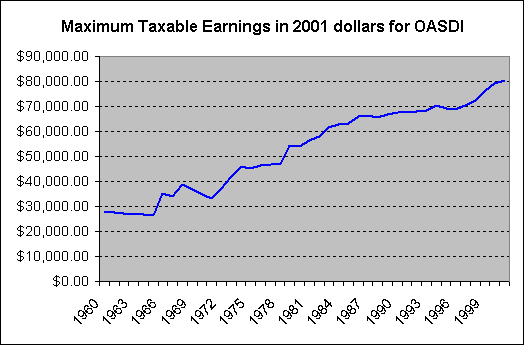
source: http://www.ssa.gov/history/pdf/t2a3.pdf
As you can see, this limit has been increasing since the inception of
the program. The tax rates themselves have also increased since the
inception of the program.
When Social Security was first implemented in 1937 the OASI tax rate
was 2%, and remained such until 1950 when it was increased to 2.25%.
Below is a graph of the OASI tax rates since 1950.
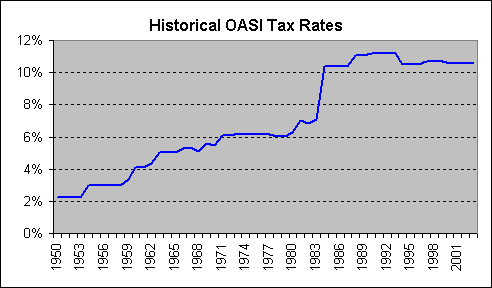
source: http://www.ssa.gov/history/pdf/t2a3.pdf
As the tax rates and limits have increased, so have the benefits.
Since its inception, the Maximum benefit payable to Social Security
beneficiaries has increased as shown below. The benefit increases are
calculated using the Average Wage Index. The Average Wage Index is based
on all national wages, even wages beyond the Maximum Taxable Earnings.
As income disparity increases in America, the Average Wage Index grows
at a rate faster than the rate of inflation or the wages that are taxed
by OASDI. The spike in the 1970s is known as "the notch" and was a
product of a miscalculation that resulted in higher payouts to
beneficiaries than was supposed to occur.
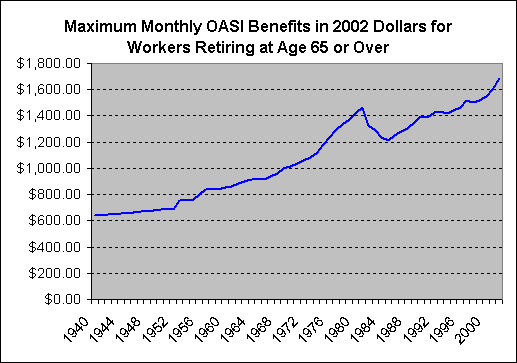
source: http://www.ssa.gov/history/pdf/Table2a28.pdf
In the early days after the implementation of Social Security, the
ratio of workers to beneficiaries was very high. This was because most
of the people paying into the program had not yet begun drawing
benefits. In 1940 the number of workers to beneficiaries was 159.4 to 1,
meaning that for every person receiving benefits there were 159.4 people
paying into the program. By 1945 the ratio had already dropped to 41.5
to 1, and by 1970 the ratio of workers to beneficiaries had stabilized
near its current level at about 3 to 1. In fact, from the mid 1970s
through the 1980s the ratio of workers to beneficiaries was slightly
lower than it is today. (see source for details)
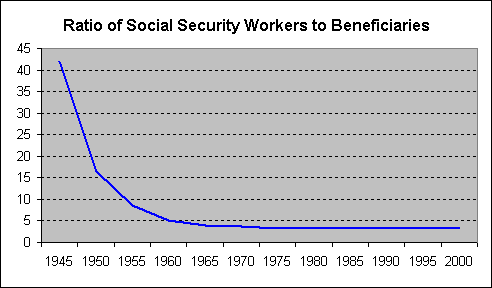
source:
http://www.ssa.gov/history/ratios.html
The ratio of workers to beneficiaries is currently projected to
decrease to 2 to 1 by 2030 and to 1.8 to 1 by 2076
As was stated earlier, Social Security taxes typically bring in more
revenue than needs to be paid out, and when this happens that excess is
put into trust funds. There is a separate trust fund for each Social
Security program and each of the trust funds operates somewhat
differently. The HI and DI trust funds are the funds that are currently
projected to run out of funds first, however, as has been stated, the
privatization program does not address these funds and focuses on the
OASI program, which has the least problems. The OASI trust fund is
currently projected to run out of funds anywhere from 2042 to 2075, at
which point it is projected that 73% of its current projected
obligations could be met directly from taxation alone.
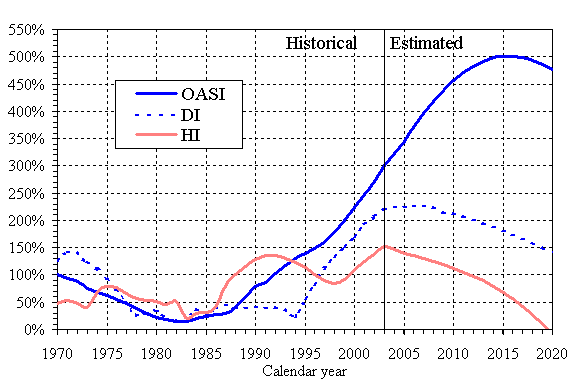
OASI, DI, and HI trust fund ratios as a percentage of annual
expenditures
The OASI trust fund is the major fund, with the largest amount of
capital. The money for the trust fund is invested into low risk
government bonds. In 1999 the rate of return for the OASI and DI trust
fund investments was about 6.9%.
The revenue for OASDI comes from three major sources, taxation of
wages, interest on the trust fund, and taxation of benefits. In 2003 83%
of OASDI revenue came from taxation of wages, 13% came from trust fund
interest, and 2% came from taxation of benefits.
Due to the simple nature of the Social Security system,
administrative costs are very low. For the OASI program, administrative
costs are under 1%. In 2003 the administrative cost of the OASI program
was 0.6%. This administrative cost is less than half of the
administrative costs for a typical private mutual fund.
One peculiar aspect of the Social Security trust funds is that
because the trust funds are invested in special issue government bonds,
the trust funds effectively represent loans to the federal government,
and the interest on the Social Security investments has to be paid back
by money raised from general taxation. This, however, is how all
government bonds work, including those that are privately held by
investors. Because of the huge size of the Social Security trust funds,
however, when these bonds need to be redeemed on large scale to help pay
for benefits, it will mean that general taxes will likely have to be
raised to pay back the bonds.
Now, having laid out some general information about Social Security,
we can move on to some analysis and discussion of the issues at hand.
source: A Summary of the 2004 Annual Reports
Social Security and the Economy
In many ways, the Social Security system is serving as a leading
economic indicator. The problems evident in Social Security financing
are in reality a product of the problems that all working-class people
in America face.
What is not discussed about Social Security in the mainstream media
is the economic environment and how changes in our economic environment
since 1940 impact the Social Security system.
One of the many claims made about Social Security by those who are in
favor of president Bush's privatization plan is the claim that the ratio
of workers to beneficiaries is much lower today than in the past, and
that this is part of the problem as to why Social Security is not
sustainable in its current form. The following is an example of such a
claim found in popular media:
The current system is unsustainable. Over the next generation or
two, Social Security faces a projected shortfall of at least $3.5
trillion. One big reason: the ratio of workers to retirees is
shrinking. Just after World War II, there were 16 workers supporting
each retiree. Today, that ratio is 3 to 1. By 2030, it will be less
than 2 to 1.
NAVARETTE- Social Security reality- 'Buddy, can you
spare me $3.5 trillion?'
This is a dubious claim. As was noted above, the ratio of workers to
beneficiaries stabilized at around 3 to 1 in 1970. It is true that the
ratio of workers to beneficiaries is projected to be about 2 to 1 by
2030, but in fact this is not a dramatic decrease. The Social Security
system has been performing just fine for the past 30 years with 3
workers supporting every retiree and the system is still bringing in
more revenue than it pays out today.
What is not discussed in the article are the following facts:
Productivity has increased dramatically throughout the 20th century,
as shown below:
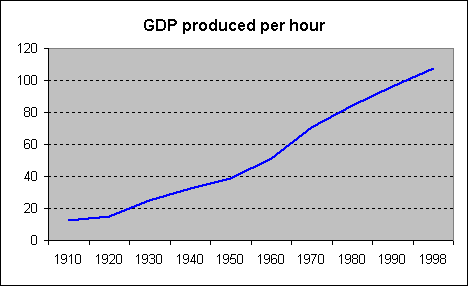
source: http://pw1.netcom.com/~rdavis2/wagegap.html
So, while the number of people supporting beneficiaries is decreasing
slightly over time, we are producing more value for every hour spent
working than in the past as well.
This gets into a more fundamental discussion of economics. Forget
about the money, forget about the percentages and the ratios, and let's
get back to basics here.
Social Security is a way for current workers to provide a basic level
of care for non-workers, specifically people who, themselves, have
worked to help create our society and who have, themselves, paid to take
care of the elderly and disabled before them.
What this means is that this is a system of redistribution. It's
taking part of the value that a present day worker creates and it's
giving it to someone else to help them live. It's the same principle
that has been present in civilization throughout history. People never
depended on saving enough resources throughout their life to live on
once they became elderly; the current working generation has
traditionally set some of their resources aside to help care for the
aged and disabled.
Let's use a very basic example. Let's use the example of a worker at
a lumber mill based on the GDP per hour information above.
Let's say that in 1970 a man worked in a lumber mill, and this man
was able to cut 70 logs a day. In 1970 the Social Security tax rate was
6.3%, so every day 5 logs were subtracted from his pile and those logs
were used to pay towards the living expenses of a retired person.
Together, 3.7 workers contributing 5 logs a day from their 70 log
pile was enough to pay for the benefits given to a retiree: 18.5 logs a
day.
By 1998 a worker at that same lumber mill was producing 107 logs a
day and, due to the 15.3% Social Security tax rate, 16 logs were taken
from his pile each day to give to a beneficiary. At that time, it took
3.3 people contributing 16 logs a day to makeup what was given to one
retiree, 52.8 logs.
This represents an increase in the benefits received by retirees in
1998 over those in 1970, although the ratio of workers to retirees had
gone down.
While compensation to beneficiaries had increased, the workers still
had more logs for themselves also, because productivity had increased.
In 1970 the worker had 65 logs to himself at the end of the day, and in
1998 the worker had 91 logs to himself at the end of the day.
Assuming that productivity continues to increase, and there is no
reason to believe that it won't, there should be no problem with the
number of workers per beneficiary decreasing…. Except…
Except the fact that our economic system doesn't really work this
way.
The above example would apply if we had a purely worker based
economy, but we don't, and if GDP was a measure of beneficial output,
but it isn't. There are other major elements to the equation: profits
(capital gains) and income distribution, as well as the fact that GDP
only measures economic activity, not necessarily economic benefit. An
increasing amount of American economic activity is what many would call,
non-productive, in other words, things like producing junk mail or
paying lawyers to settle divorce cases, etc.
Since the 1970s the share of national income going to labor has
decreased. In 1979 the share of national income going to labor was
73.2%. By 2000 that figure had dropped to 70.5%, although it has come
back up slightly to 71% in 2004 since the Stock Market bubble burst of
2001.
Not only has the share of national income received by holders of
capital increased since the 1970s, but wage disparity has increased as
well, with dramatic increases in high-end income. For example, between
1982 and 2002 the average compensation of corporate executives increased
by a factor of 10. At the same time, median income for working males has
been flat since 1970 in inflation-adjusted terms.
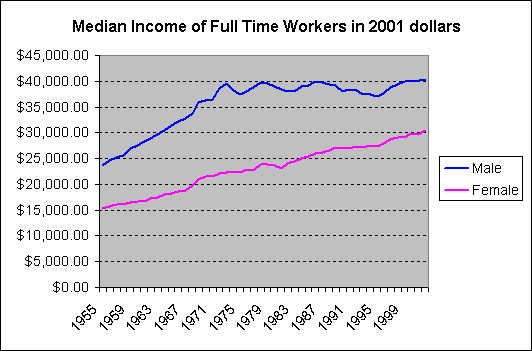
source: http://www.census.gov/hhes/income/histinc/ineqtoc.html
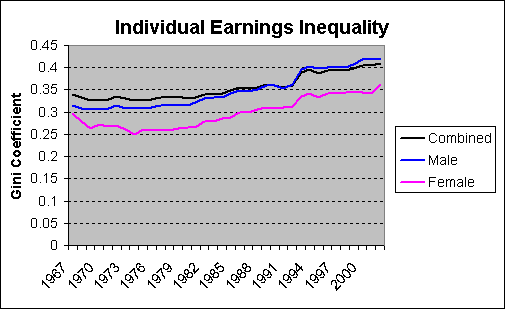
source: http://www.census.gov/hhes/income/histinc/histinctb.html
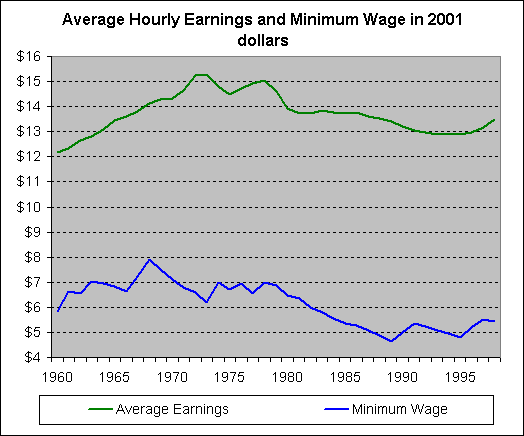
http://w3.access.gpo.gov/usbudget/fy2000/sheets/b047.xls
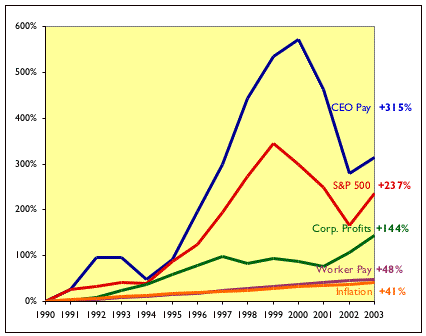
source: http://www.faireconomy.org/research/CEO_Pay_charts.html
The IRS reported that total taxable executive pay between 1980 and
1995 increased from $109 billion to $307.6 billion in inflation-adjusted
dollars. This is a 182% increase in taxable pay that far exceeded growth
in either corporate revenues or net income. Revenues increased by 129.5%
and corporate profits increased by 127% over the same time period.
During this same time period, wages for the 80% of the working
population that make up non-supervisory workers actually declined when
adjusted for inflation.
source: CEO Compensation- A Problem That Just Gets Worse
It is important here to bear in mind that there is an upper limit on
the OASDI tax, above which the tax does not apply. In 2000 that upper
limit was $76,200. The figure below shows approximately what portion of
labor income was untaxed by OASDI taxes in 2000. The portion in red is
above the OASDI taxation limit and thus exempt from OASDI taxation.
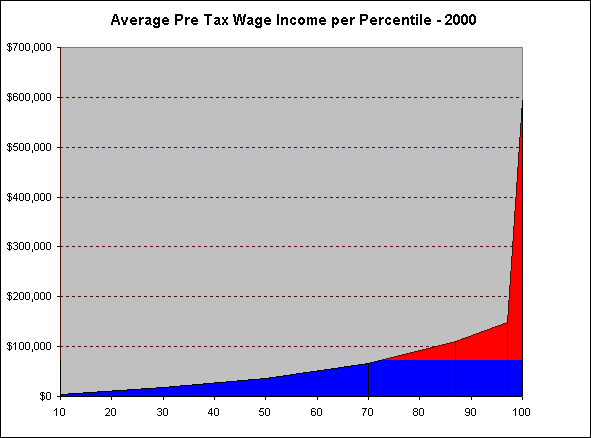
As you can see, a large portion of the nation's labor income is
untaxed by OASDI taxes. The Social Security taxes fall most heavily on
the middle class. In 2000 the top 1% paid an average of 1.9% of their
income to Social Security taxes, while the middle class, the 40th
to the 80th percentile, paid an average of 10% of their
income to Social Security taxes.
For example, the average wage income for the top 1% in 2000 was
$595,000, of which only the first $76,200 was taxed by OASDI.
Understanding how labor compensation works is also important here.
The capitalist system is based on the use of labor markets to determine
wages, and this means that compensation is not directly related to
productivity. Changes in wage distribution do not necessarily reflect
changes in productivity distribution.
Both of these factors, the decrease in the share of national income
going to labor and the increase in income disparity with a dramatic rise
in high-end wages at the top of the income spectrum, have resulted in a
shrinking "tax base", not because of the number of retirees per worker,
but because a larger portion of national income is not subject to the
OASDI taxes, either because it is above the limit or it is realized in
the form of capital gains, i.e. profits.
At the same time, the way that benefits are calculated for Social
Security is based on the Average Wage Index. The Average Wage Index is
computed using all wages that are taxed by federal income taxes. That
means that as income disparity increases, the average wage increases at
a higher rate than the median wage or the rate of inflation. This means
that the middle-class is called on to pay increasing benefits based on
wages that the middle-class is not receiving. The graph below shows the
growing divergence between the average and median wage.
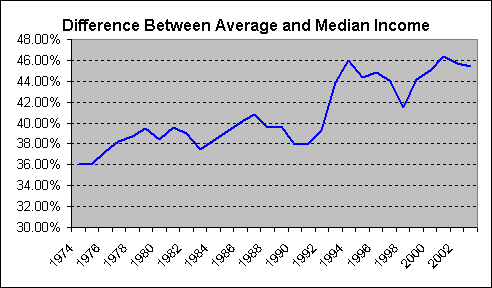
We can now reapply these facts to our logging example.
Not only are workers as a whole today keeping a smaller share of the
logs that they produce at work than they were in 1970, but a larger
percentage of the logs produced are being distributed to a minority at
the top end of the pay scale, above the limits of the OASDI tax limits.
In 1970 the worker at the lumber mill cut 70 logs a day. These logs
all went into one big stack in the center of the lumberyard and no one
kept a direct count of the logs that each worker produced.
When the worker took his job he agreed to do the work for 30 logs a
day because other people agreed to do the job for 30 logs a day.
Since the overall return to labor at that time was 73%, or 49 logs
out of 70, this meant that he was getting about 19 logs less than the
total return to labor.
The other 19 logs went towards paying managers and other workers at
the company.
Of the logs he was paid, about 12% were taxed away by the federal
government for general taxes and 6.9% were taken for Social Security.
This left him with 24.3 logs, and he contributed 2.1 logs to care for a
retiree.
In 2000 a worker in that same lumber mill produced 107 logs a day,
all of which went to the central company stack.
When he took his job he agreed to do it for 30 logs a day as well,
because remember that in inflation- adjusted dollars median pay for male
workers in the US has been stagnant since 1970, meaning that average
male workers today are being compensated the same as they were in 1970.
Since the overall return to labor in 2000 was 70%, or 75 logs out of
107, this means that he was getting about 45 logs less than the total
return to labor, again, these 45 logs represent a part of the return to
labor that went to compensate mangers, etc.
Of the 30 logs he was paid, the federal government took 10% for
general taxes and 15% for Social Security. This left him with 22.7 logs
and he contributed 4.5 logs to care for a retiree.
If we take the 2.1 logs from 1970 and multiply it by 3.7 workers then
we have 7.7 logs per retiree.
If we take 4.5 logs from 2000 and multiply it by 3.3 workers we have
14.85 logs per retiree.
The increase in compensation for Social Security beneficiaries
between 1970 and today has come not from increases in productivity, but
from increases in taxation, because OASDI taxes are income capped wage
taxes and the increases in productivity in America since the 1970s have
not been reflected in the incomes of ordinary working class Americans,
who are the base of the Social Security system.
This is the real root source of the problem, it is the fact that a
smaller and smaller portion of national income, i.e. what is produced,
is actually subject to Social Security taxes because average workers are
receiving a smaller and smaller share of the national income pie. This
is why Social Security taxes have had to increase so much to pay
benefits, even while productivity has dramatically improved over the
years.
So, how does this relate to Bush's proposal to partially privatize
Social Security?
Privatization of Social Security
If an increasing share of national income is going to capital then
wouldn't privatization of Social Security take advantage of this? Yes
and no. I am not fundamentally opposed to the development of a national
investment system, in fact I have been advocating such a system for
three years, as discussed in this article: Understanding Capitalism Part
I- Capital and Society
Despite that, there are still problems with president Bush's approach
and with the arguments that are advanced in favor of his plan. One of
the often heard statements in support of partial privatization of Social
Security is that the average return in "the Stock Market" over time has
been 10%, and that this 10% would be better for people who pay into the
program than the "returns" currently offered by Social Security.
There are many issues with this line of reasoning. First of all,
there is no real rate of return on Social Security, although it is often
claimed that the rate of return from Social Security is around 2%, this
number is actually completely meaningless. There is no real measurable
rate of return for Social Security precisely because no one "owns" any
shares in it. Paying into Social Security entitles you to a certain
level of benefits, but there is no way to take all of the benefits in a
lump sum or anything of that nature, so there is no real way to say that
there is a rate of return. What you get out of Social Security depends
on how long you live. If you die before you ever collect any benefits
then you get nothing, and your dependants may or may not be able to get
a part of your benefits. An average wage-earner retiring in 2003 will
get back what they contributed to Social Security in 7.5 years. All
payments from Social Security after that are in excess of contributions
made.
If you die at age 70, after having only gotten a few years of
benefits, then your "return" is less than if you live to 100 and collect
Social Security benefits for 35 years.
That's really part of the point, again, of "Social" Security. We all
pay in so that whoever lives a long time, or becomes debilitated due to
injury, will have some means of support so that they don't become a
burden on society. If you live to be 100 then you still get your checks,
you don't have worry about running out of money. If you get diagnosed
with terminal cancer and have 6 months to live then, unlike a private
account, you can't get a big lump sum and blow it on gambling in Vegas.
Again, it's a social insurance program, not a retirement
account.
So, any discussion of "rate of return" from "your" Social Security
investment is meaningless. As was stated earlier, the Social Security
trust funds earn around 5% to 7% interest.
Secondly, as for the claim that the historic rate of return for the
Stock Market is 10%, this rate of return has always fluctuated
dramatically over time, as we have seen just recently with the Stock
Market bubble of 2000 and 2001. When people are retired, these
fluctuations could have major impacts on meeting needs.
That, however, is not even the major issue. The real fact is that, as
investors will tell you, past performance is not indicative of future
results. It doesn't matter if you are discussing specific stocks or the
entire market, past performance is not an
indicator of future results.
The 20th century saw an unprecedented level of growth. The
population of the United States increased by 360% between 1900 and 2000.
Over the next 50 years the US population is projected to grow by 47% to
a whopping 400 million, but this rate of growth for the next 50 years
will still be many times smaller than what occurred over the past
century.
In addition to that, the United States of America was one of the
leaders of the Industrial Revolution and remained as the only major
industrial power in the world after World War II due to the destruction
that affected almost every country in the world except America. Today we
face much stronger international economic competition than ever before.
Additionally, the United States rose to industrial power during a
time of unprecedented cheap energy costs, and as we are aware today,
cheap energy will likely be a thing of the past for a least a few
generations to come as oil supplies continue to dwindle and demand
continues to rise. In the event of a major technological breakthrough a
new source of cheap energy may replace oil, but there is no proven
replacement yet.
On top of all that, the American dollar is continuing to decline in
value and will likely never regain the dominance that it had during the
last half of the 20th century because the adoption of the greenback as
the international reserve currency was a product of post World War II
treaties and agreements related to the Cold War. These conditions simply
don't exist anymore.
These factors, and others, make predicting a 10% return on the Stock
Market over the next 50 years a very dubious claim. The rate of return
in the American Stock Market for the 21st century will likely
be lower than it was during the 20th century for completely
understandable fundamental reasons.
On top of these facts, any partial privatization of Social Security
would inherently make the system more complex and increase the cost of
operation.
While President Bush's endorsement of an "ownership society" based on
stock ownership is certainly a good idea, the devil is in the details.
A major problem with partial privatization of the OASI program is
that the OASI benefits are very stable and secure, and this security is
a large part of their importance, not only to individuals, but as a
stabilizing effect on the entire economy. OASI benefits provide for the
basic needs of many retirees, without which many of them would be unable
to meet their daily living expenses. This means that fluctuations in
benefits due to Stock Market activity could have a major impact on the
economy as a whole.
The graph below shows 20th century business cycles in America. The
implementation of Social Security in the 1940s was a major factor in the
stabilization of the American economy in the 20th century.
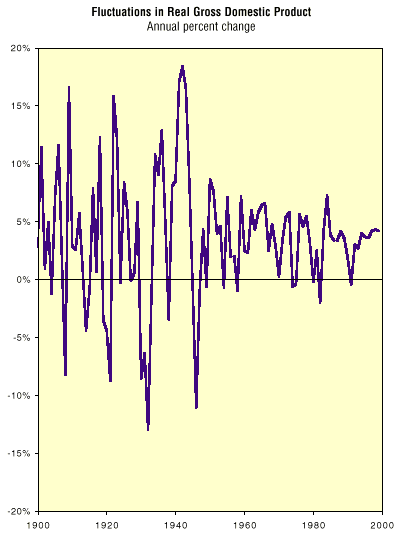
source: http://www.pbs.org/fmc/book/14business2.htm
OASI benefits should be maintained as they are because introducing
increased risk for this type of system is very dangerous. This could
certainly increase economic volatility and lead to extended recessions
and depressions in the future because when a drop in the Stock Market
does occur that would mean that many retirees, who would be dependant on
the values of their privatized Social Security accounts, would
immediately see diminishing benefits themselves, which could lead to
major decreases in spending among the large retirement population,
further deepening a depression, not to mention the problems caused by
large numbers of retirees who may be unable to meet existing financial
obligations, such as rent and utility bills.
Our Social Security system is a form of national economic
diversification. Tying too much of our economy into the Stock Market
decreases total national diversification and increases total national
economic risk.
In terms of a national investment system, I am in favor of such a
program, however I think that it should be separate from Social
Security. We should create a new national investment system, and not
privatize the OASI portion of Social Security because it is filling the
role that it is intended to fill, Social Security. Keyword security. What should definitely be
done is that benefit increases should be based on either the rate of
inflation or on median wages, instead of on
the Average Wage Index. What could also be done, is that the cap on the
OASDI taxes could be removed without increasing the maximum benefit
payments to compensate. If this were done the overall OASDI tax rates
could also be reduced. At the very least the DI portion of the OASDI tax
should have its cap removed. This would make the DI program solvent
beyond the term of current projections at least, if not indefinitely,
and the DI program is a program that supports disabled citizens. Surely
caring for this group should not be the sole responsibility of the
middle class.
The problem with the idea of partial privatization of Social Security
is that it does not address the root causes of the problems. The OASI
fund is the most economically sound fund. The funds with the biggest
problems are the HI and SMI funds. These funds, the Medicare funds, face
immediate problems and privatization in no way addresses these problems.
Medicare reform and healthcare reform are much more important than
retirement benefit reform, and it was the Bush administration that
failed to support the best opportunity to control costs within Medicare
that has come along in a long time, and that was when Bush signed the
Medicare reform bill in 2004 that forbids Medicare from negotiating
lower prescription drug prices.
Furthermore, the projected distant future shortfall for the OASI fund
is a product of a flaw in how benefit increases are calculated that is
exacerbated by an underlying problem of the country, which is that
income disparity is increasing and the middle class is being
increasingly squeezed economically. This, of course, impacts the ability
of the middle class to pay for the support of retirees.
The fact of the matter is that in a nation of increasing productivity
there should be no need to extend the working time of citizens, or to
increase tax rates, or to cut benefits in order to pay for the needs of
retired workers and the disabled, even with a decreasing ratio of
workers to beneficiaries.
It is fallacious to say that as a society "we" can't afford to
maintain retirement benefits. The fact is that "we" can, but the middle
class cannot. "We" can afford to pay basketball players millions of
dollars a year to play games. "We" could afford to spend $11.2 billion
on cigarette advertising in 2001. "We" could afford to compensate the
CEOs of the 365 largest companies an average of $8.1 million each in
2003.
It's not as though "we" can't afford to care for our elderly and
disabled, its a matter of our priorities as a society however. When we
say that "we" can't afford Social Security, what we are saying is that
professional athletes receiving millions of dollars a year are more
important to us than retirees.
If that's where people's values are, then that's where they are, but
let's not pretend as though this is the result of an acute funding
crisis; the problems with Social Security are a reflection of the
problems within our entire society. The real solution for fixing Social
Security is to fix the underlying problems.
See also:
Getting a grip on Social Security: The flaw in the
system
Social Security Reform 2005
For more on the Bush administration's framing of
the Social Security debate see:
Social
Security- Bush's Lies vs. Reality
Move over Gingrich, Frank Luntz is the new Goebbels
|